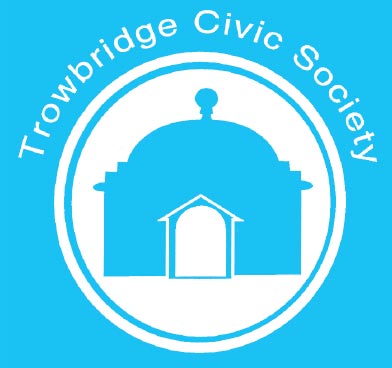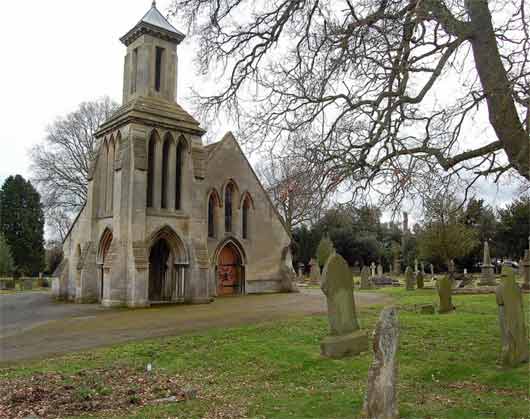| ||||||||||||||||||||||||||||
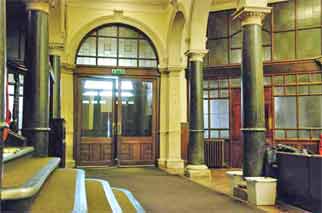 |
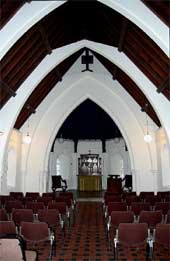 |
Town Hall Lobby | Non-conformist (above) Anglican (below) | 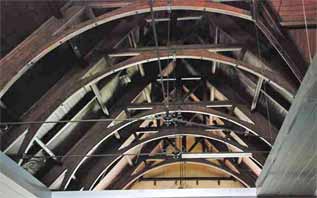 | 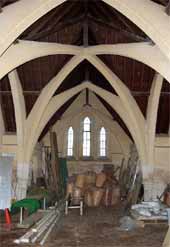 |
Town Hall Roof | 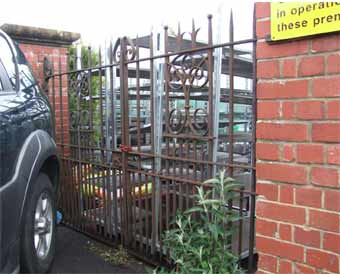 | Chapel Interiors |
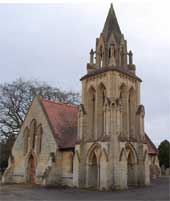 | |
Original Entrance to Palmer Gardens | Anglican Chapel |
Contents
Click on the item to go to the article. |
Editorial CommentThis issue of the newsletter seems to
have a leaning towards the “hereafter” with an article on cemetery chapels and an account of the society visit to Trowbridge Cemetery - on a rainy day. Deadline for copy for the summer edition is Friday 28th September. |
Forthcoming Events
| 2012 | ||
| Date and Time | Event | Venue or Meeting Point |
| Saturday 16th June 15:00 to 17:00 |
Cream Tea Afternoon and Bring & Buy. By kind invitation of Mr and Mrs Andrew King | 14 Holbrook Lane, Trowbridge |
| Tuesday 3rd July 19:00 |
A guided walk around Warminster. Led by a member of Warminster History Society. | Meet at back door of Warminster Library situated in car park of Station Road. |
| Wednesday 8th August Leaving approx 08:30 |
Trip to Arnos Vale Cemetery Bristol (guided tour), Bristol Waterfront (lunch) and ending at Blaise Castle | Full details soon |
| Thursday 6th - Sunday 9th September Various Times |
Heritage Open Days | Various sites open. Click here for more details. |
| Tuesday 29th October 19:30 |
“The Frome Hoard” - Talk by Dave Crisp who found over 52,000 Roman coins near Frome | Haden Room, United Church, Church Street, Trowbridge. |
| Tuesday 13th November 19:30 |
PUBLIC LECTURE “Wiltshire and the Wyatts: an architectural dynasty and their local connections” by Kevin Eames |
Haden Room, United Church, Church Street, Trowbridge. |
To arrange for a lift or to volunteer to car share please contact Glyn on 755784
FROM THE CHAIRMAN |
The recent open day at the Town Hall was a great success. Visitors were able to view an art exhibition in the foyer and then go on guided tours from the cells in the basement to the caretakers flat on the top floor with its spectacular view over the People's Park. The organ loft is the only place where the expanse of the vast roof can be seen in its entirety. From this position you can also view the huge amount of heating apparatus and other paraphernalia which would have to be removed in order to reinstate the Great Hall.
There is an enormous amount of work to be done but when complete as a centre for the arts in Trowbridge it will, I am sure, prove to be a great asset for the town and surrounding area. If you are interested in helping in any way the group can be contacted on one of the following: info@trowbridgetownhall.org, or via the website at www.trowbridgetownhall.org.
Another exciting development for the town is the proposed move of the Trowbridge Museum to Courtfield House, the former Roundstone Preparatory School. In its present location the museum cannot expand its activities because the owners of the Shires will not provide a lease long enough for the Heritage Lottery to give a grant for the development of the top floor.
The Courtfield House site would provide space for new build and the old wool store would be a perfect setting for the woollen machinery which could be operated as it was when the museum first opened. Together with its on site parking it would be a perfect location. We can only hope that the Town Council will have the vision to see the project through to fruition.
Planning Matters |
I am sure you will have read in the local press that the Legal and General application for the “Mount Crushmore” site in St Stephen's Place has been approved. As for the old Bowyers' site the BBC reported on 10th May - “A decision on plans for a second cinema complex has been deferred for six weeks. Plans for the eight-screen cinema, on the old Bowyers site in Trowbridge, had been recommended for refusal. But the council's planning committee put off the decision so new terms and conditions could be drawn up with a view to it being approved”.
Demolition and re-development of the former Tremens building in Court Street was approved 3 years ago. Their application for renewal was successful. Approval has also been given for 80 unit Solar Array at Whaddon Lane, Hilperton. The Friends of Biss Meadow Country Park have had their plans approved to redevelop the pond and surrounding area. We wish them success in raising the funds to carry out the work.
As mentioned in an earlier newsletter, we raised objections to the plans to buld 3 houses within the grounds of Rodwell Hall. The application has been withdrawn. It will be interesting to see what changes are made before they re-submit the plans.
AGM - 13th March 2012 |
Glyn Bridges, as Chairman, welcomed members to the Annual General Meeting. Apologies were received from nine members who were unable to be present.
During the brief business meeting Glyn Bridges was re-elected Chairman. He said that as he had been Chairman for many years he felt it was time for a change and he hoped that someone would come forward to take on the post of Chairman at the next AGM. Janet Carpenter was elected Treasurer following Kay Austin's move out of the area and Celia Russell was elected as Secretary. The Executive Committee members, Peter Bull, Kevin Hartley, Jonathan Hawkes, Margaret Howard, Diana Ingram and Diana King were re-elected. Mr Patrick Andrews who has been our auditor for some considerable time has now stepped down and Joanna Fox has kindly agreed to act as auditor.
Under “Any Other Business” the Chairman said Ken Rogers is arranging a day out on 18th July to Newark Park and Frampton Court on behalf of Friends of the Museum. If there are insufficient "Friends" to fill the coach it will be opened up to Civic Society members. The Chairman also mentioned the “Woollen Trail” leaflet which is in the course of preparation. Peter Collier, on behalf of the Newsletter team said they welcome contributions from members for the Newsletter.
Trowbridge Jubilee Town Hall |
Trowbridge Town Hall has been closed to the general public for many years and, most recently, only the ground floor has been in use as a Coroner's Court. With the Coroner's Court closing towards the end of the year, and Wiltshire Council anxious to cut costs, Trowbridge Town Hall, built to celebrate Queen Victoria's Golden Jubilee in 1887, is among the first of many public heritage buildings to be off-loaded from local authority ownership. With the cost of renovation so high, mainly because of the substantial interior alterations made by the court service, and the complications of a Grade II listing, the prospect of finding a buyer in the private sector with the resources to turn the building round seems remote. The perils of this solution are clearly apparent in Warminster Town Hall and the Assizes Court at Devizes. Community groups were offered the first opportunity to buy the building, provided they could demonstrate a viable plan to secure its financial future, with the alternative being to put the building onto the open market.
As the deadline for a community bid to take over the building approached last autumn, Mary Pearce, principal of Roundstone School, called a public meeting to consider the issue. The meeting was well attended and came just at the time when the news of the imminent closure of the Arc Theatre for professional performance was breaking. The informed suggestion, proposed by Tracy Sullivan, a former director of the Arc, that the Town Hall could be converted for use as a professional arts centre with potential for community use and commercial lettings, was enthusiastically received by the meeting. A small group of volunteers - the Town Hall Group - signed up to carry the project forward.
The concept of a professional Arts Centre, with its prospects for Arts Council funding and obvious community benefits, is an exciting prospect, and Tracy Sullivan has been conducting detailed research into the project since last November. Nevertheless, in order to be deemed sufficiently robust to attract the level of grant funding and investment which will be required to pull it off, the project must be tested against other possibilities for a financially viable use for the building.
The Town Hall Group is fortunate to have the expertise of Ian Walker, who is a chartered quantity surveyor specialising in the conservation and reuse of historical buildings.
The Town Hall Group's first action was a successful bid, sponsored by Councillor John Knight and presented by Tracy Sullivan, for the ring-fencing of funds from the Area Board towards the cost of the necessary feasibility study, with match-funding pledged by Trowbridge Community Area Futures. The feasibility study commissioned by Trowbridge Town Council in 2005 has been made available to the Town Hall Group, and will form a useful basis for the current study. Now a Board has been appointed, with experience and expertise in all the areas necessary to carry the project forward to the stage where they can demonstrate its viability to attract the kind of income through a carefully designed blend of grants funding and community and commercial enterprise necessary for such an ambitious venture.
It has been said that Trowbridge is not the kind of town which could support a dedicated arts centre, but the events of the recent weekend opening of the Town Hall gave the lie to this perception. The Town Hall Group had arranged for the Town Hall to be open to the public for the first time for several years, and were therefore able to accommodate Jude Edward's Affordable Arts Fair, when his existing arrangements fell through at the last minute. The Arts Fair was an evident success, with a stream of local artists arriving to set up their exhibits and an excited buzz of visitors, the display changing from day to day, as pieces were sold and others took their place.
The happy accident of the Arts Fair coinciding with the Town Hall opening clearly demonstrated that there is an artistic community in the local area, and also the appetite among local people to support them. The desire of the townspeople to get inside their Town Hall was palpable and inspiring. Many local people remember a time when the Town Hall was the centre of popular entertainment in the town and long to see it recover this role. With the courts and local government gone from the building, this aspect of its heritage could come to the fore, and all the myriad of offices, court rooms and chambers be brought into use for any number of rehearsals, workshops and meetings of every kind. With the Great Hall brought back to its former glory and sympathetically adapted into a flexible performance and function space - which is the central aspiration of this vision - the Town Hall could support so many levels of cultural activity for the town, from tiny local interest groups and dance classes to local choirs and amateur theatre, and from comedy nights and popular music to full scale professional performance.
As someone who came from London only ten years ago, I never saw the Town Hall in its heyday, but it is clear from my own small-scale researches that there was a time when everyone who came into Trowbridge knew there was a rich cultural life going on here, and they knew exactly where to find it too. The Town Hall was given to the town as much more than a centre for local government and justice, though it had a long and distinguished career in both those roles. It was purposely designed to be an impressive venue for entertainment and public assembly, and was given as such to the people of Trowbridge to commemorate the Golden Jubilee of Queen Victoria. Our own Queen Elizabeth's Diamond Jubilee seems a very auspicious time for the people to claim it back again. If you would like to find out more, please visit the website at www.trowbridgetownhall.org.
PALMER GARDENS- One Hundred Years Old |
May 15th 2012 was the 100th anniversary of the opening of Palmer Gardens. An item in a local newspaper of September 1910 announced that Mrs G Palmer was presenting Trowbridge with “a new recreation ground situated in front of the County Ground. Its main feature will be the development of school gardens and the fostering of the practical as well as the beautiful.” The garden was opened in 1912 and is now known as Palmer Gardens. In the 1980s the garden was taken over by the Shaw Trust and has become a successful garden centre.
But who was Mrs Palmer? She was Louie Madeleine Palmer, the step-daughter of Mr William Gouldsmith, a local clothier who lived at Rodwell Hall, and she was in the party that laid the Memorial Stone of the new cottage hospital in the Halve in 1883. She married George Llewellen Palmer in 1881 and, according to his obituary in the Wiltshire Gazette of 1932, he and his wife
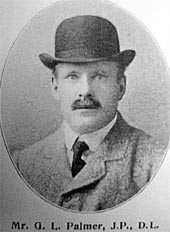 were also the “donors of almshouses in Trowbridge” and “for a long period were very generous benefactors to the town, they being most charitably disposed.”
were also the “donors of almshouses in Trowbridge” and “for a long period were very generous benefactors to the town, they being most charitably disposed.”
Brigadier General George Llewellen Palmer, JP, CB, DL was once a very prominent figure in Wiltshire, the only son of Michael Palmer who was head of Palmer and Mackay, owning woollen mills and weaving factories in Trowbridge. He was born in 1857 and lived first at Berryfield in Bradford on Avon. He was educated at Harrow and in his 20s became part of the family firm. At the age of 24 he married his wife and they lived first at Springfield in Trowbridge, but in 1900 they went to live at Lackham, “the General being Lord of the Manor”. He had bought that house in 1893, making many alterations to it before moving in. In 1887 he became a magistrate and was also a Deputy Lieutenant. In 1903 he was High Sheriff of Wiltshire. After some years the couple returned to Trowbridge to live at the Prospect and in 1925 he became President of the Hospital Committee. (When he died he left £1000 to the hospital). He had joined the Royal Wiltshire Yeomanry and in 1911 became a colonel. During the First World War he was eventually promoted to Brigadier General and also created a CB. In 1918 he was elected as a Conservative MP for Westbury. He held it only until 1922 when the Liberals regained the seat. His wife died in 1925 and he married again. They moved to Bexley, Kent, where he died in 1932. He was buried at Lacock in the family grave.
He had a lifelong interest in sport; he was one of the founders of the Avon Vale Hunt, he gave the pavilion which once existed in Bythesea Road to Trowbridge FC and, with Mr Charles Awdrey and others, led the way to the acquisition of the cricket ground at Trowbridge for the Wiltshire County Cricket Club.
It was in his wife's name that he also provided the ‘Palmer’ piece of ground in the same locality as a playground for the young and as a pleasure ground for the old. The Wiltshire Times of May 18th 1912 reported that there was no formal opening and the old stone wall “has been pulled down and in its place and continuing right round the gardens enclosure has been erected a low wall of red brick surmounted by an ornamental iron railing - a very handsome form of boundary – through which views of the gardens are disclosed.” There was also an inscription in the wall recording the fact of Mrs Llewellen's gift. Unfortunately, this has long since deteriorated and the original stone, which is still in the grounds, only has the words “Wiltshire County Council” remaining.
The gardens were “for the use and enjoyment of children attending public elementary schools in Trowbridge or for such other purposes of the council as the local education authority may from time to time think fit.” At the start the gardens were divided up into four plots, each one belonging to a group of schools. The schools involved were Newtown, Trinity, Parochial and Adcroft. The plots were mainly planted with vegetables, but flower beds were also planted by the girls' schools (!). A pond was also constructed. The long Wiltshire Times report even details the types of plants that will be grown as well as giving the names of some of the teachers involved.
Later, it seems, the gardens were used as school gardens mainly by Adcroft Senior Boys' School and as an evening class gardening centre until 1939. During the war the gardens were used for food production and afterwards they were a demonstration teaching centre for teachers and children and as a county supply for plants for Wiltshire schools and colleges as well as to old peoples' homes and police stations. Then in 1981 the County Council controversially decided to sell the gardens to save money. It was then that the Shaw Trust took over.
Shaw Trust started in the village of Shaw in Wiltshire and was registered as a charity in 1982. It was set up originally by five local people to help a small group of disabled individuals achieve their employment aims. In 1984 the Trust was able to take over the two acre nursery of Palmer Gardens, with the aim of providing “employment, training and vocational opportunities for young, severely disabled people in the area”. Shaw Trust is now one of the largest providers of employment services for disabled people in the UK, employing around 1600 people, and “works with around 78,000 clients a year to overcome barriers to employment, inclusion and independence”.
In August 2012 there will be a special birthday celebration to commemorate the anniversary. See the local press for further details.
Thanks to Ken Rogers and Timothy Goodman of Palmer Gardens for providing information for this article.
Trowbridge Community Awards Ceremony |
These took place at the Civic Centre on Wednesday April 25th and Janet Carpenter and I were very pleased to see that several members of the Trowbridge Civic Society were among the recipients.
Peter Bull, (who unfortunately is at present in the RUH at Bath following a fall two days before the ceremony) was one, who received his award for his work for Trowbridge Museum, Sally Taylor another member for her work in the Community, Andy Milroy also for his contributions to Trowbridge and Kevin Hartley who received an award for covering Trowbridge Council Events and shadowing the Mayor at his events (photography). Mary Pearce a founder member of TCS received just a mention for all her work in Trowbridge including her work towards the education of children at her school. Mayor Nick Blakemore who co-presented the ceremony with Trevor Heeks is also a member of Trowbridge Civic Society.
The ceremony was preceded by a very interesting talk by Major Davison of the Trowbridge Cadets who emphasised that the members of his Division were a very enthusiastic group of boys and girls who put a lot of work into becoming a cadet - they even won a National Bugling Competition last year although they only set up their band last year. He was very disappointed that we hear so often of the hoodies and drug addicts who make life in Trowbridge difficult for many but seldom hear about the good work done by youngsters such as the cadets who belong to a flourishing organisation.
Why and When did the Polish Community |
WHY?
On August 22, 1939, a few days before the official start of World War II, Hitler authorized his commanders, with these infamous words, to kill “without pity or mercy, all men, women, and children of Polish descent or language. Only in this way can we obtain the living space [lebensraum] we need”.
On the 1st September, 1939 German armed forces invaded Poland from the West and on the 17th September 1939 the Soviet Union invaded from the East. Despite phenomenal resistance to both invaders the Polish defence eventually collapsed. Thousands of men, women and children living in the West were arrested and taken into concentration camps and similarly thousands of people were arrested and deported into the Soviet Union. Stalin wanted to destroy eastern Poland and absorb it into the Soviet Union, so he confiscated land, property and businesses, and deported over 1.5 million Polish people to slave labour camps in Kazakhstan, Uzbekistan and Siberia. Many died because of appalling conditions during the journeys and at the camps. Many ex-soldiers escaped through Hungary, Czechoslovakia and Romania to Syria, France and other countries and started the formation of the Polish Armed Forces in the West.
In June 1941 Germany invaded Russia, and Stalin needed help to fight this new enemy. A Polish-Soviet treaty was agreed allowing the release of all Poles held in labour camps and the formation of a new Polish army. But the Russians were reluctant to lose their slave labourers, and out of the 1.5 million deported Poles who had survived, only 160,500 managed to escape from the camps. The Poles struggled to reach southern Russia, where the Polish army was reassembling under General Anders. In 1942 Anders' army (with Churchill's help) and Polish civilians were evacuated 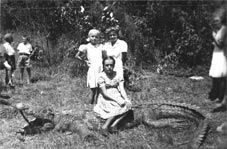 from the Soviet Union to British-controlled Persia (Iran). Anders' army joined the Allied forces in Europe. Polish children and families were sent from Iran to India, Africa, Mexico and New Zealand where they remained for the rest of the war.
from the Soviet Union to British-controlled Persia (Iran). Anders' army joined the Allied forces in Europe. Polish children and families were sent from Iran to India, Africa, Mexico and New Zealand where they remained for the rest of the war.
My mother Anna, my 4 sisters and 1 brother were deported to Siberia and eventually when released in 1941 my mother, my brother and surviving sister managed to make their way South to be taken to Persia. They stayed for a few months to regain their strength. My father by then was with the Polish army under exile fighting with the British. Eventually the dispersal of Polish refugees took place and my mother, brother and sister were put on a ship (I found the Red Cross list from the ship on the web!)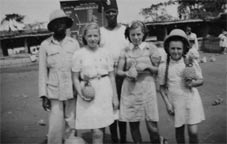 and assigned to the camp at Koja in Uganda, Africa.
Although the camp was quite primitive it was located in a beautiful setting on a peninsula jutting out into Lake Victoria, surrounded by water on three sides and jungle and savannah on the fourth. They stayed there until early 1948 when the camp was being disbanded and
joined my father, who was now in England and being demobilised. My mother’s registration certificate states her arrival into the UK as 08.03.1948 to Daglingworth Camp in Cirencester.
and assigned to the camp at Koja in Uganda, Africa.
Although the camp was quite primitive it was located in a beautiful setting on a peninsula jutting out into Lake Victoria, surrounded by water on three sides and jungle and savannah on the fourth. They stayed there until early 1948 when the camp was being disbanded and
joined my father, who was now in England and being demobilised. My mother’s registration certificate states her arrival into the UK as 08.03.1948 to Daglingworth Camp in Cirencester.
WHEN?
Shortly after in 1948 the family was billeted at one of the camps in Keevil. Like most WW2 airfields the camp was built on requisitioned land in 1941 under emergency powers with the intention of returning the land to its owners when hostilities ceased. The camp was of a typical wartime design providing basic accommodation, catering facilities, washroom facilities, a small recreation hall which contained a library and workshops. Here the Polish refugees settled 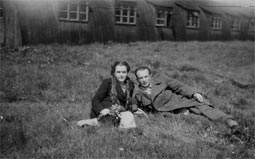 down and found civilian employment in nearby towns, such as Trowbridge, Melksham, Westbury and eventually moving out of the camp and buying houses (mid to late 50's). The majority of inhabitants moved to
Trowbridge where there is still a thriving community with the Polish Hall/church/bar at its centre in Waterworks Road. The hall is well used for various functions and there is a well attended Saturday morning Polish language school for the children. The Polish folk dancing group “Kujawy” which was formed in 1960 still continues to give performances in various towns and cities. Although a great majority of the original “refugees” have passed away some of their offspring still continue the Polish traditions. Moreover, with the new influx of post communist Poles, Trowbridge continues to have a good percentage of Polish population and it is noted that quite a few of the signs and posters around the town and in the shops are in both the English and Polish language.
down and found civilian employment in nearby towns, such as Trowbridge, Melksham, Westbury and eventually moving out of the camp and buying houses (mid to late 50's). The majority of inhabitants moved to
Trowbridge where there is still a thriving community with the Polish Hall/church/bar at its centre in Waterworks Road. The hall is well used for various functions and there is a well attended Saturday morning Polish language school for the children. The Polish folk dancing group “Kujawy” which was formed in 1960 still continues to give performances in various towns and cities. Although a great majority of the original “refugees” have passed away some of their offspring still continue the Polish traditions. Moreover, with the new influx of post communist Poles, Trowbridge continues to have a good percentage of Polish population and it is noted that quite a few of the signs and posters around the town and in the shops are in both the English and Polish language.
Finally, it appears that there was one other major reason why the polish refugees settled in the UK or around the world 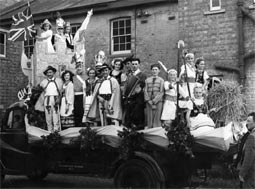 and that was that they felt betrayed that the Poland that they had fought for was diametrically opposed to the ideology of the democratic system for which they had fought. The decision reached by the Three Great Powers at Teheran in 1943 robbed Poland of its Eastern territories, made the country a satellite of the Soviet Union, and established a Communist political system in Poland. For that reason and fear of oppression if
they returned, the majority of Polish ex-combatants did not return. Thanks to the Solidarity movement communism fell in 1989 and Poland is once more a democracy.
and that was that they felt betrayed that the Poland that they had fought for was diametrically opposed to the ideology of the democratic system for which they had fought. The decision reached by the Three Great Powers at Teheran in 1943 robbed Poland of its Eastern territories, made the country a satellite of the Soviet Union, and established a Communist political system in Poland. For that reason and fear of oppression if
they returned, the majority of Polish ex-combatants did not return. Thanks to the Solidarity movement communism fell in 1989 and Poland is once more a democracy.
Note: For an extremely readable story based on the above events read “Poles Apart” by Chris Piechowski a local Salisbury
author. Available through Waterstones and Amazon.
RECENT MEETINGS |
Organised Crime, Crime Waves and Thieves in Hoodies - Crime in the Middle Ages by Martyn Whittock 13th March
After the AGM Martyn gave us a lively talk and presentation on this fascinating subject. He started by looking at the Anglo-Saxon foundations which provided a well-organised and well maintained legal system. He then looked at the growth of Common Law, the law that applied across the country and described how people tried to enforce the law in what was quite a violent and litigious society. However, villeins, people who were tied to the land, and had very few rights, and women also had very limited access to the courts. Martyn also described the development of Royal Courts and the bringing in of Justices of the Peace. There were no proper prisons, except Clink prison, until after 1576. The majority of the punishments were fines or execution! For example the theft of an item worth more than 10 pence was punished by death. Levels of crime seemed to be quite high. Fourteenth century East Anglia had relatively similar levels of crime to modern day New York.
Our speaker also looked briefly at the legend or myth of Robin Hood, the original hoodie! Apparently, during the thirteenth century there were many criminals across the country who gave their names as a variant of Robehod and the name became popular in stories and songs from that time. As Roger Newman pointed out, Doncaster/Sheffield airport is now named after Robin Hood and that is where the legend seems to have first started, not Notingham!
We all felt at the end that we had learnt a great deal especially about attitudes to crime in this part of our history.
The Cemetery Chapels in |
In Trowbridge, we are very lucky to have a cemetery which is, according to Chris Brooks, ‘For a small town, ... of remarkable interest and quality.’ It was opened in 1855, and was brought about by the creation of a local Burial Board, after the arrangements laid down in the Metropolitan Burial Act of 1852 were extended to England and Wales in 1853. This was made necessary because of the dangers to public health caused by overflowing churchyards and by the inadequacy of commercial burial grounds such as Brookwood in Surrey, which were seen as prioritising private profit over public need and hygiene. Thus, if ten ratepayers in a parish considered a new cemetery to be necessary, the Secretary of State would be informed, and a Burial Board set up, consisting of between three and nine ratepayers, who would be appointed by periodical elections. Expenses were to be taken out of the Poor Rate, and Boards were empowered to borrow money and to make compulsory purchases of land where required.
Once set up, Boards were encouraged to proceed ‘with all convenient speed’, (Brooks) and the Trowbridge Board seemed to follow this advice, for the cemetery was opened two years after the Act was passed. The architect was Major Charles Edward Davis, of Bath, who later became the City Architect, and designed such features of the Bath cityscape as the Terrace on Orange Grove, Grand Parade with its supporting colonnade, and the “wildly fanciful” Empire Hotel (Forsythe).
The lodge at the entrance to Trowbridge Cemetery is large and Gothic, of ashlar, and it leads to ‘a fine gloomy avenue of yew bushes’ (Brooks) which runs through the cemetery, with the chapels to either side, staggered slightly.
The first chapel, to the left of the avenue, is the Anglican one and, like its counterpart, the non-conformist chapel further along, it is Grade II listed. The chapel itself is of a conventional design, with lancet windows and cruciform in plan. The tower and spire beside it form ‘a steeple of eccentric but highly effective design’ (Brooks). It's in three stages, with the lower stage (I think) providing shelter for the coffin before it is taken into the chapel through the side door - although members of the Society might be able to provide further enlightenment on this. The door itself is certainly worth looking at for the quality of its ironwork. The second stage is elongated, with paired lancets opening it up on three sides, and the third stage consists of a lantern with gables, from which rises the spire. Inside, the chapel is used as a storage space and workroom, while the strong ribs and timbers of the roof show the good condition the building is in, contrasting with many cemetery chapels in the country as a whole.
The non-conformist chapel, nearby but on the opposite side of the avenue, is also in a lancet style. There is, again, an impressive steeple, with the stages not demarcated as strongly as in the Anglican chapel. The lanceted openings on the second stage, open on all four sides, are plainer than in the corresponding Anglican steeple, and the upper stage is ‘Italianate’, ‘capped by a pyramidal roof’ (Brooks). This chapel has a polygonal apse at the East end, which is visible in the photograph of the interior, which also shows the building in a state of readiness for a funeral, as the chapel is still in operation, used for its intended purpose – but these days it serves Anglican as well as non-conformist denominations.
The excellent state of preservation of these Victorian gems is a tribute to the care given by Wiltshire Council, and by the Burials Team in particular. I should like to thank Margaret Curran, the team leader, for her friendly help and advice, and for making access possible.
If any readers wish to investigate cemetery chapels in other areas, they can access the still-developing survey being carried out by the Victorian Society; the web address is http://www.victoriansociety.org.uk/.
Brooks, C. (1989) ‘Mortal Remains: the history and present state of the Victorian and Edwardian cemetery’ Exeter:Wheaton
Forsythe, M. (2003) ‘Pevsner's Architectural Guides: Bath’ New Haven and London: Yale University Press
| Welcome to the following new members: | Mr and Mrs J Nutt |
Trowbridge Cemetery visit 22 April 2012
On a chilly, showery Sunday afternoon a group of about 20 civic society members gathered at Trowbridge Cemetery for a tour led by Ken Rogers, who started off by saying he imagined that most of us knew as much about the cemetery as 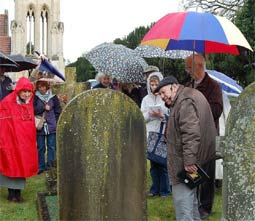 he did. Although several of the group had a great deal of local knowledge, Ken's vast wealth of detailed information was
breathtaking. We started at the Anglican Chapel and Ken explained the problem of disposing of bodies in the 19th Century
because of lack of space. He told us that there were several small graveyards attached to churches and chapels but then, in 1838, Trinity churchyard opened. In 1853 an act was passed that allowed Burial Boards to be set up and in 1855 a Burial Board cemetery was opened in Trowbridge, with buildings designed by C.E. Davis (who also designed the former Market House,
he did. Although several of the group had a great deal of local knowledge, Ken's vast wealth of detailed information was
breathtaking. We started at the Anglican Chapel and Ken explained the problem of disposing of bodies in the 19th Century
because of lack of space. He told us that there were several small graveyards attached to churches and chapels but then, in 1838, Trinity churchyard opened. In 1853 an act was passed that allowed Burial Boards to be set up and in 1855 a Burial Board cemetery was opened in Trowbridge, with buildings designed by C.E. Davis (who also designed the former Market House,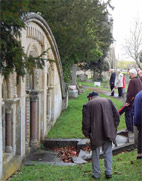 now the Sir Isaac Pitman).
now the Sir Isaac Pitman).
We examined many of the graves in the non-conformist section of the cemetery, starting with Ann Vine's. On her headstone was mentioned William Vine who was Ken's great-great grandfather but died too early to be buried in the cemetery. We looked at the mausoleum dedicated to Sir Roger Brown, a wealthy clothier, who used some of his money to
build the house that is now Fieldways Hotel. As we came to the unmarked graves, Ken referred to paupers' burials and told us that anyone who died in poverty was entitled to be provided with a coffin and a woollen shroud, and to have the cemetery bell tolled to mark the burial. He talked to us about the graves in the Anglican section again with details of occupations, family histories and places of work or residence. On our way back to the entrance we looked at the magnificent mausoleum containing members of the Hastings and Kingston families. and appreciated the restoration work carried out by the Civic Society in 1982. We were all very grateful to Ken for such an informative and entertaining talk and for generously giving up two hours of his Sunday afternoon to show us around.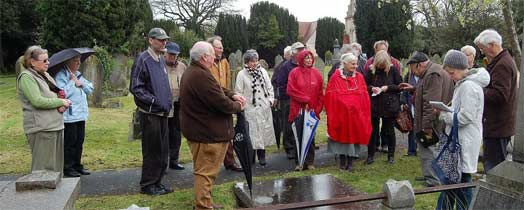
Where are these Trowbridge date plaques? |
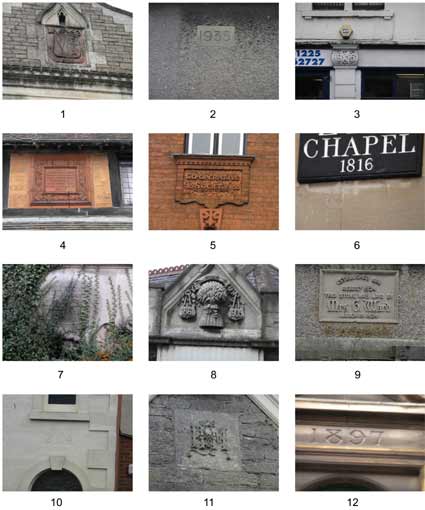
| Can you identify them all? Click on the plaque to reveal the answers - no cheating! | 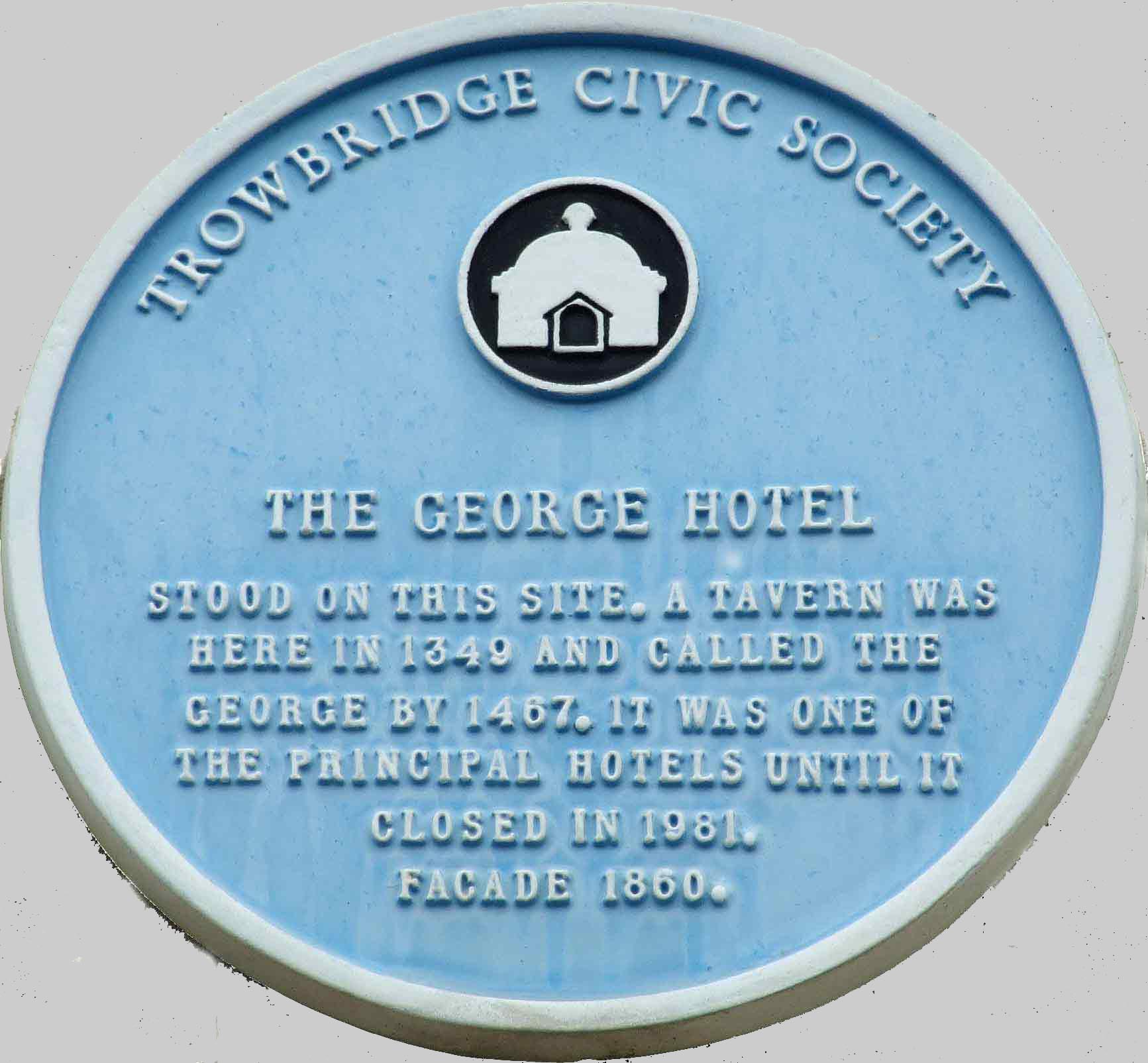 |
Answers to the Roofs of Trowbridge Quiz in the Spring Issue
|
|
